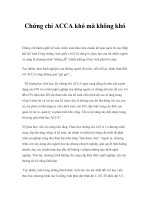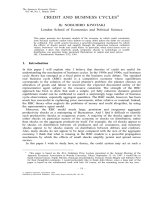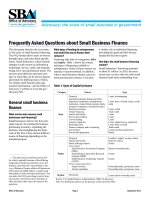acca test book Business Taxation docx
Bạn đang xem bản rút gọn của tài liệu. Xem và tải ngay bản đầy đủ của tài liệu tại đây (353.7 KB, 8 trang )
PAGE 3
AIM
To develop knowledge and understanding
in the core areas of tax related to
businesses and their employees.
OBJECTIVES
On completion of this paper candidates
should be able to:
• explain the operation of the UK tax
system
• prepare computations of the corporation
tax liability for individual companies
and groups of companies
• prepare computations of the income tax
liability for employees, sole traders and
partnerships
• prepare computations of the chargeable
gains arising on incorporated and
unincorporated businesses
• explain and apply the principles and
scope of Value Added Tax
• explain the impact of National
Insurance Contributions on employees,
employers and the self-employed
• explain the use of exemptions and
reliefs in deferring or minimising tax
liabilities
• demonstrate the skills expected at Part 2.
POSITION OF THE PAPER IN THE
OVERALL SYLLABUS
An understanding of the formats of
accounts used for sole traders, partnerships
and companies from Paper 1.1 Preparing
Financial Statements is assumed. There is
no substantial integration with other papers
in Part 2.
Paper 2.3
Business Taxation
(United Kingdom)
The coverage in Paper 2.3 will provide the
grounding for the study of the optional
Paper 3.2 Advanced Taxation.
Paper 3.2 develops the topics by applying
the tax knowledge to problems encountered
in practice, by giving more emphasis to
planning to minimise or defer tax and by
examining the interaction of taxes.
SYLLABUS CONTENT
1 Corporate businesses
(a) Scope of corporation tax.
(b) Residence.
(c) Profits chargeable to corporation tax
(i) schedule D case I
(ii) capital allowances
(iii) relief for trading losses
(iv) schedule A
(v) schedule D case III
(vi)Charges on income.
(d) Chargeable gains
(i) principles and scope
(ii) the basis of calculation
(iii) the identification and application
of relevant exemptions and reliefs.
(e) Calculation of the corporation tax liability.
(f) Overseas aspects
(i) trading overseas via a subsidiary
or a branch
(ii) double taxation relief
(iii) transfer pricing.
(g) Groups of companies.
(h) Self assessment system.
(i) Value Added Tax.
2 Unincorporated businesses
(a) Basic income tax computation.
(b) Self assessment system.
(c) Schedule D case I/II
(i) badges of trade
(ii) computation of assessable profit
(iii) basis of assessment
(iv)change of accounting date
(v) capital allowances
(vi)relief for trading losses
(vii) partnerships and limited liability
partnerships
3.2 Advanced Taxation
2.3 Business Taxation
PAGE 4
Paper 2.3: Business Taxation (United Kingdom) (Continued)
(viii) personal pensions.
(d) Capital gains tax
(i) principles and scope (restricted to
business assets)
(ii) the basis of calculation
(iii) the identification and application
of relevant exemptions and reliefs.
(e) Value Added Tax.
(f) Class 2 and Class 4 NIC.
3 Employees
(a) Employment Income
(i) basis of assessment
(ii) allowable deductions
(iii) PAYE system
(iv)benefits.
(b) Occupational pension schemes.
(c) Class 1 and Class 1A NIC.
4 Tax planning
(a) Employment v self-employment.
(b) Remuneration packages.
(c) Choice of business medium.
(d) Incorporation of a business.
(e) Disposal of a business.
(f) Directors and shareholders.
EXCLUDED TOPICS
The following topics are specifically
excluded from Paper 2.3:
1 Corporate businesses
(a) Scope of corporation tax
(i) investment companies
(ii) close companies
(iii) companies in receivership and
liquidation
(iv) anti-avoidance legislation
(v) reorganisations
(vi) purchase by a company of its
own shares
(vii) personal service companies.
(c) Profits chargeable to corporation tax
(i) research and development
expenditure
(ii) the 100% first-year allowance for
flats above shops
(iii) the 100% first-year allowance
for water technologies
(iv)capital allowances for agricultural
buildings, patents, scientific
research and know how
(v) in respect of industrial buildings
allowance: enterprise zones,
initial allowances, and the sale of
an industrial building at less than
original cost following a period of
non-industrial use (note that
sales for more than original cost
are examinable)
(vi)furnished holiday lettings
(vii) non-trading deficits on loan
relationships
(viii) trade charges on income
(ix)relief for intangible assets
(x) the corporate venturing scheme.
(d) Chargeable gains
(i) assets held at 31 March 1982
(ii) part disposals
(iii) negligible value claims
(iv)leases, chattels and wasting
assets
(v) a detailed question on the
pooling provisions for shares
(vi) the same day and nine day
matching rules for shares and
securities applicable to corporate
businesses.
(vii) substantial shareholdings
(f) Overseas aspects
(i) controlled foreign companies
(ii) foreign companies trading in the
UK
(iii) expense relief in respect of
overseas tax
(iv)the restriction of double taxation
relief for underlying tax to the full
rate of corporation tax
(v) the carry back and carry forward
of unrelieved foreign tax.
(g) Groups of companies
(i) consortia
(ii) 51% groups and group income
elections
(iii) pre-entry gains and losses
(iv) the anti-avoidance provisions
where arrangements exist for a
company to leave a group
(v) the tax charge that applies where
a company leaves a group within
six years of receiving an asset by
way of a no gain/no loss transfer.
(h) Self assessment system
(i) form CT61 and quarterly
accounting for income tax.
(i) Value Added Tax
(i) group registration
(ii) imports, exports and trading
within the European Community
(iii) partial exemption
(iv)second-hand goods scheme
Business Taxation (United Kingdom)
PAGE 5
Paper 2.3: Business Taxation (United Kingdom) (Continued)
(v) the capital goods scheme
(vi)in respect of property and land:
leases, do-it-yourself builders,
and the landlord's option to tax
(vii) penalties apart from the default
surcharge, serious
misdeclarations (but not repeated
misdeclarations) and default
interest
(viii) special schemes for retailers.
2 Unincorporated businesses
(a) Basic income tax computation
(i) personal allowances other than
the personal allowance for people
aged under 65
(ii) tax credits
(iii) non-trade charges on income
(iv)joint property of husbands and
wives, maintenance payments
and minor children
(v) schedule A
(vi)schedules D cases III and VI
(vii) individual savings accounts
(viii) the enterprise investment
scheme and venture capital trusts
(ix)foreign income, non-residents
and double taxation relief
(x) income from trusts and
settlements
(xi)anti-avoidance legislation.
(c) Schedule D case I/II
(i) as for corporate businesses
(ii) farmers averaging of profits
(iii) the averaging of profits for
authors and creative artists
(iv) loss relief for shares in unquoted
trading companies
(v) investment income and charges
of a partnership
(vi)the allocation of notional profits
and losses for a partnership.
(d) Capital gains tax
(i) as for corporate businesses
(ii) calculation of the indexation
allowance
(iii) reinvestment relief
(iv)principal private residence
(v) partnership capital gains
(vi) overseas aspects
(vii) losses in the year of death
(viii) the transfer of assets between a
husband and wife
(ix)the exemption of gilt edged
securities and qualifying
corporate bonds
(x) the payment of CGT by annual
instalments
(xi)capital sums received in respect
of the loss, destruction or
damage of an asset.
(xii) relief for losses incurred on
loans made to traders.
(e) Value Added Tax
(i) as for corporate businesses.
(f) Class 2 and Class 4 NIC
(i) the offset of trading losses
against non-trading income (for
Class 4 NIC).
3 Employees
(a) Employment Income
(i) the calculation of a car benefit
where emission figures are not
available
(ii) share and share option incentive
schemes for employees
(iii) payments on the termination of
employment, and other lump
sums received by employees.
(b) Occupational pension schemes
(i) a detailed knowledge of the
conditions that must be met to
obtain Inland Revenue approval
for an occupation pension
scheme
(ii) the option for certain
occupational pension schemes to
apply to be subject to the
personal pension scheme rules.
(c) Class 1 and Class 1A NIC
(i) the calculation of directors’ NIC
on a month by month basis.
KEY AREAS OF THE SYLLABUS
The key topic areas, taken directly from the
syllabus content list, are as follows:
1 Corporate businesses
(a) Scope of corporation tax.
(b) Profits chargeable to corporation tax.
(c) Calculation of the corporation tax
liability.
(d) Self assessment system.
Business Taxation (United Kingdom)
PAGE 6
2 Unincorporated businesses
(a) Basic income tax computation.
(b) Self assessment system.
(c) Schedule D case I/II.
3 Employees
(a) Employment Income
APPROACH TO EXAMINING THE
SYLLABUS
The examination is a three hour paper
divided into two sections.
Only core topics will be examined in
Section A. A non-core topic may form part
of a question (such as a chargeable gain in
a corporation tax computation), but this
will account for a maximum of ten marks.
At least 40 of the 55 available marks in
Section A will be of a computational nature.
• Question 1 will be on a corporate
business (for approximately 30 marks).
• Question 2 will be on an unincorporated
business and/or employees (for
approximately 25 marks).
The questions in Section B will be a mix of
computational and written, and include the
minimisation or deferral of tax liabilities by
the identification and application of
relevant exemptions and reliefs.
• Question 3 will be on VAT (either for an
incorporated business or an
unincorporated business).
• Question 4 will be on capital gains
(either for an incorporated business or
an unincorporated business).
• Question 5 will be on either groups of
companies or overseas aspects.
• Question 6 will be on one of the six
listed tax planning topics.
• Question 7 will be on any area of the
syllabus, but will typically deal with a
core topic that has not been covered in
Section A.
Number
of Marks
Section A: 2 compulsory questions 55
Section B: Choice of 3 from 5
questions (15 marks each) 45
100
Tax rates, allowances and benefits will be
given in the examination paper.
ADDITIONAL INFORMATION
The ACCA applies a six-month rule in that
questions requiring an understanding of
new legislation will not be set until at least
six calendar months after the last day of
the month in which the legislation received
Royal Assent. The same rule applies to the
effective date of the provisions of an Act
introduced by Statutory Instrument. It
would, however, be considered
inappropriate to examine legislation it is
proposed to repeal or substantially alter.
Knowledge of section numbers will not be
needed to understand questions in this paper,
nor will students be expected to use them in
their answers. If students wish to refer to
section numbers in their answers they may
do so and will not be penalised if old, or
even incorrect, section numbers are used.
Business Taxation (United Kingdom)
Names of cases or a detailed knowledge of
the judgement are not required but
knowledge of the principles decided in
leading cases is required.
The Study Guide provides more detailed
guidance on the syllabus.
RELEVANT TEXTS
There are a number of sources from which
you can obtain a series of materials written
for the ACCA examinations. These are
listed below:
Foulks Lynch – ACCA's official publisher
Contact number: +44 (0)20 8831 9990.
Website: www.foulkslynch.com
Accountancy Tuition Centre (ATC)
International
Contact number: +44 (0)141 880 6469.
Website: www.ptc-global.com
BPP
Contact number: +44 (0)20 8740 2211.
Website: www.bpp.com
The Financial Training Company
Contact number: +44 (0)174 785 4302.
Website: www.financial-company.com
Candidates may also find the following texts
useful:
A Homer and R Burrows Tolley’s Tax
Guide Tolley Publishing ISBN 1860128319
A Melville Taxation Prentice Hall
ISBN 0 273 655522–1
PAGE 7
STUDY SESSIONS
1 Corporate businesses
(a) Scope of corporation tax
(i) Define the terms ‘period of
account’, ‘accounting period’, and
‘financial year’
(ii) Explain when an accounting
period starts and finishes
(b) Residence
(i) Explain how the residence of a
company is determined
(c) Profits chargeable to corporation tax
(i) Schedule D case I
– State the expenditure that is
allowable in calculating the
tax-adjusted profit
– Explain how relief can be
obtained for pre-trading
expenditure
(ii) Capital allowances
– Define plant and machinery for
capital allowances purposes
– Calculate writing down
allowances and first year
allowances
– Explain the treatment of motor cars
– Compute balancing
allowances and charges
– Explain the treatment of short
life assets and long life assets
– Define an industrial building
for industrial buildings
allowance purposes
– Calculate industrial buildings
allowance for new and
second-hand buildings
– Compute the balancing
adjustment on the disposal of
an industrial building
(iii) Relief for trading losses
– Explain how trading losses
can be carried forward
– Explain how trading losses
can be claimed against
income of the current or
previous accounting periods
– State the factors that will
influence the choice of loss
relief claim
(iv)Schedule A
– Compute the Schedule A
profit
– Explain the treatment of a
premium received for the
grant of a short lease
– Explain how relief for a
Schedule A loss is given
(v) Schedule D case III
– Explain how profits from loan
relationships and interest
received are assessed under
Schedule D case III
(vi)Charges on income
– Explain the treatment of
charges on income
(d) Chargeable gains
(i) Principles and scope
– Prepare a basic capital gains
computation
– State the allowable
deductions
– Calculate the indexation
allowance
(ii) The basis of calculation
– Explain the treatment of
capital losses
– Explain the identification rules
for disposals of shares and
securities
– Apply the pooling provisions
for shares and securities
– Explain the treatment
following a bonus issue, rights
issue or takeover (as a result
of the chargeable gain part
disposal rules not being
examinable, any question on
the takeover of shares or
securities will involve a paper
for paper transaction.
Reorganisations are not
mentioned in the Study Guide.
This is because all the
relevant rules can be examined
by way of a takeover (for
example, where shareholders
receive two different classes
of share in exchange for their
existing shareholding))
(iii) The identification and
application of relevant
exemptions and reliefs
– Explain and apply rollover
relief
Business Taxation (United Kingdom)
Wider reading is also available especially
regular study of the relevant articles in
ACCA's student accountant.
PAGE 8
(e) Calculation of the corporation tax
liability
(i) Prepare a basic corporation tax
computation
(ii) Explain the implications of
receiving franked investment
income
(iii) Calculate the corporation tax
liability at the starting rate, small
company rate and full rate, and
apply tapering relief
(f) Overseas aspects
(i) Trading overseas via a subsidiary
or a branch
– Compare the UK tax
treatment of an overseas
branch to an overseas
subsidiary
(ii) Double taxation relief
– Calculate double taxation
relief for withholding tax and
underlying tax
(iii) Transfer pricing
– Explain and apply the transfer
pricing rules
(g) Groups of companies
(i) Define an associated company
(ii) Define a 75% group
(iii) Explain and apply the reliefs
available to members of a 75%
group
(iv)Define a 75% capital gains group
(v) Explain and apply the reliefs
available to members of a 75%
capital gains group
(h) Self assessment system
(i) Describe the features of self-
assessment
(ii) Explain how the Inland Revenue
can enquire into a self-
assessment return
(iii) Calculate interest on overdue tax
(iv) Explain how large companies are
required to account for
corporation tax on a quarterly
basis.
(i) Value Added Tax
(i) Describe the scope of VAT
(ii) State the circumstances in which
a person must register for VAT,
and explain the advantages of
voluntary VAT registration
(iii) State the circumstances in which
pre-registration input VAT can be
recovered
(iv) Explain how a person can
deregister for VAT
(v) Explain how VAT is accounted for
and administered
(vi) Explain how the tax point is
determined
(vii) List the information that must
be given on a VAT invoice
(viii) Describe the principles that
apply to the valuation of supplies
(ix)State the circumstances in which
input VAT is non-deductible
(x) Describe the relief that is
available for bad debts
(xi) List the principal zero-rated and
exempt supplies
(xii) Describe the cash accounting,
the annual accounting and flat
rate schemes
(xiii) State the circumstances in
which the default surcharge, a
serious misdeclaration penalty,
and default interest will be
applied
2 Unincorporated businesses
(a) Basic income tax computation
(i) Prepare a basic income tax
computation
(ii) Explain the treatment of savings
income and dividends
(iii) Explain the treatment of trade
charges on income
(b) Self assessment system
(i) Describe the features of self-
assessment
(ii) Calculate payments on account
and balancing payments/
repayments
(iii) Calculate interest on overdue tax
and state the penalties that can
be charged
(iv) Explain how the Inland Revenue
can enquire into a self-
assessment return
(c) Schedule D case I/II
(i) Badges of trade
– Describe and apply the
badges of trade
(ii) Computation of assessable profit
– As for corporate businesses
Business Taxation (United Kingdom)
PAGE 9
(iii) Basis of assessment
– Explain the basis of
assessment
– Compute the assessable
profits on commencement and
cessation
(iv)Change of accounting date
– State the factors that will
influence the choice of
accounting date
– State the conditions that must
be met for a change of
accounting date to be valid
– Compute the assessable
profits on a change of
accounting date
(v) Capital allowances
– As for corporate businesses
(vi)Relief for trading losses
– Explain how trading losses
can be carried forward
(although only trade charges
are examinable, the impact of
non-trade charges where
trade charges are carried
forward is examinable. In any
examination question on this
area, a figure for non-trade
charges will simply be given.
The carry forward of losses on
incorporation is examinable)
– Explain how trading losses
can be claimed against total
income and chargeable gains
– Explain the relief for trading
losses in the early years of a
trade
– Explain terminal loss relief
(vii) Partnerships and limited liability
partnerships
– Explain how a partnership is
assessed to tax
– Allocate assessable profits
between the partners following
a change in the profit sharing
ratio or a change in the
members of the partnership
– Describe the alternative loss
relief claims that are available
to partners
– Explain the loss relief
restriction that applies to the
partners of a limited liability
partnership
(viii) Personal pensions
– Explain the relief given for
contributions to a personal
pension scheme
(d) Capital gains tax
(i) Principles and scope (restricted to
business assets)
– As for corporate businesses
– Define a business asset for
the purposes of taper relief.
– Compute taper relief
(including non-business
assets)
(ii) The basis of calculation
– As for corporate businesses
(quoted shares and securities
(including the valuation rules)
are examinable since certain
quoted shareholdings will
qualify for business asset
Business Taxation (United Kingdom)
taper relief. The indexation
allowance is not examinable
for individual taxpayers.
Therefore, any question
involving shares and securities
will simply give a figure for
the value of the 1985 pool as
at 5 April 1998)
(iii) The identification and
application of relevant
exemptions and reliefs
– As for corporate businesses
– Explain and apply holdover
relief for the gift of business
assets
– Explain and apply the relief
available when a business is
transferred to a limited
company.
(e) Value Added Tax
(i) As for corporate businesses
(f) Class 2 and Class 4 NIC
(i) Calculate class 2 NIC
(ii) Calculate class 4 NIC
3 Employees
(a) Employment Income
(i) Basis of assessment
– State the factors that determine
whether an engagement is
treated as employment or self-
employment
– Explain the basis of assessment
– Describe the income assessable
(ii) Allowable deductions
– List the allowable deductions,
including travelling expenses
PAGE 10
Business Taxation (United Kingdom)
– Explain the use of the
statutory approved mileage
allowances
(iii) PAYE system
– Explain the PAYE system
(iv)Benefits
– Identify P11D employees
– Explain how benefits are
assessed
(b) Occupational pension schemes
(i) State the main features of an
occupational pension scheme
(ii) Explain the significance of an
occupational pension scheme
being approved by the Inland
Revenue.
(c) Class 1 and Class 1A NIC
(i) Calculate class 1 NIC
(ii) Calculate class 1A NIC
4 Tax planning
(a) Employment v self-employment
(i) Compare the tax implications of
employment as compared to self-
employment
(b) Remuneration packages
(i) Compare alternative
remuneration packages
(c) Choice of business medium
(i) Compare the tax position of a
director/shareholder with that of
a sole trader
(d) Incorporation of a business
(i) Explain the factors that must be
considered when incorporating a
business
(e) Disposal of a business
(i) Explain the tax implications
arising on the disposal of a
business
(f) Directors and shareholders
(i) Compute whether remuneration
or a dividend is the most tax
efficient way to extract profit from
a company.









